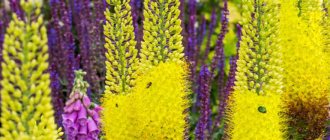It is very useful to grow calendula (marigold) in your garden. These cute bright flowers will not only decorate your flower beds, but will also repel pests. In addition, marigold flowers can be collected, dried, brewed and used as a bactericidal or anti-inflammatory agent. Growing calendula flowers from seeds is not difficult. We described in our article how to properly and when to plant seedlings in open ground in spring, summer, before winter and how to care for marigolds in the garden step by step with photos.
What does a calendula flower look like: description with photo
Since the 16th century, the calendula flower has been decorating gardens. The plant, up to 70 cm high, has elongated, lanceolate or oval leaves, pubescent stems and yellow or orange petals. The inner tubular and pseudolingular flowers of marigolds may be darker in color. Calendula begins to bloom in June and continues until the cold weather. Back in October, if there is no severe frost, you can see bright spots of marigold flowers among the gray grass in the area.
Protecting autumn flower plantings from bad weather
Frequent changes in weather conditions can cause bulbous plants to fail to sprout. Sudden temperature changes in winter have become more common lately. Awakened seeds and bulbs, deceived by the onset of warmth, are unlikely to survive subsequent frosts. To avoid such troubles, the flower beds are covered with dry grass or sawdust and covered with a thick layer of snow. The best time to insulate a flower bed is the end of October, when the temperature drops below 0 degrees.
Latest articles about gardening
When to plant calendula for seedlings and in the ground according to the timing and the Lunar calendar
To obtain early flowering, calendula seeds are sown on seedlings in March - April. You can plant directly in open ground only after the soil has warmed up at the end of April or May (depending on the climate of the region).
After sowing in the ground in spring, flowering will occur in the second half of summer. Therefore, many gardeners practice planting calendula in the fall before winter in October or November. In this case, entrances will appear in early spring, and the marigolds will begin to bloom in June-July.
Find out how and when to sow flower seeds before winter by clicking on the link.
According to the Lunar calendar in 2022, favorable days for sowing calendula for seedlings and open ground:
- 3, from 11 to 13, 16, 17, from 21 to 26, 29, 30 March;
- 8, 9, 13, 14, from 17 to 22, 25, 26, 27 April;
- 5, 6, 7, 10, 11, 14, 15, from 17 to 20, 23, 24, from 27 to 29 May;
- from 1 to 3, 6, 7, 11, 12, 13, 15, 16, 19, 20, 24, 25, 30 June;
- July 4, 5, 8 to 12, 17, 18, 21, 22, 26, 27;
- 1, from 4 to 10, 13, 14, 17, 18, 22, 23, 28 August;
- from 1 to 6, 9, 11, 13, 14, 15, 19, 20, 24, 25, 28, 29, 30 September;
- 1, 2, 7, 8, 11, 12, 16, 17, from 27 to 30 October;
- November 3, 4, 7, 13, 14, 15, 19, 20, 24, 26, 27.
You will be interested to know: Garden hydrangea: proper care in spring after winter
Throughout the summer, you can sow marigold flower seeds in open ground. They will bloom closer to autumn, reproduce by self-sowing and sprout next year in the spring.
Please note that hybrids do not reproduce in this way. This applies only to simple varieties.
Let's sum it up
Here we talked about the nuances of planting autumn flowers. The choice of flowers for autumn planting depends on your preferences and the size of the area. Therefore, be careful when choosing your flowers so that you can admire the beautiful colors next year.
To make your flower garden happy with bright colors all summer long, make a flowering calendar for your plants. Select varieties and species whose flowering follows one after another.
Sowing and growing calendula seedlings step by step with photos
For seedlings, marigold seeds are planted in deep plastic containers with drainage holes, boxes or individual pots. The containers are filled with moist flower soil.
The seeds are buried 2 cm into the ground, sprinkled with soil on top, sprayed with warm water from a spray bottle and covered with cling film or cellophane. Crops are placed in a warm place with an air temperature of +20 degrees.
Every day, the film will need to be removed for a few minutes to ventilate the substrate and check its humidity. As soon as the top layer of soil begins to dry out, it will need to be sprayed with water at room temperature.
In about a week, seedlings will begin to appear, which will need to be moved to a well-lit, cool place with an air temperature within +15 degrees.
Caring for calendula seedlings includes:
- Timely moistening of the soil. It is not recommended to over-moisten the soil, as plants may be affected by blackleg.
- Fertilize once every 7-10 days with mineral fertilizers, the concentration of which should be approximately two times less than what is written in the instructions.
- It is necessary to pick marigold seedlings after two true leaves appear on the plants. They are planted in disposable cups or peat pots and flower soil is used. After picking, the plants are watered and placed in the shade for 2-3 days, where the sun's rays do not reach.
If calendula was grown to decorate a balcony, then when picked, it can be immediately planted in flowerpots, balcony boxes or pots.
You will be interested to know: How to grow chrysanthemums from seeds: sowing and care rules
Planting seedlings in a flower bed
Having grown seedlings, it’s time to figure out when to plant calendula in open ground? This should be done after the bushes have grown, become stronger and have 5-6 true leaves. Marigolds are cold-resistant and can withstand light night frosts, so already around mid-May, after hardening procedures, they can be planted in flower beds.
For calendula, a sunny area is chosen, since only in the sun will the flowers bloom all the time, and in the shade they close. The seedlings are planted in fertile soil according to the pattern 30-40x20-25 cm.
If the seeds for seedlings were planted at the end of March, then at the beginning of June orange or yellow calendula flowers will form and begin to bloom.
Advantages of the plant
- Flowers of marigolds can be simple or double. Colors for every taste: from bright yellow to dark orange.
- There are tall and low growing varieties .
- The plant is unpretentious , is not afraid of the cold, and requires minimal care. Loves moisture.
- The soil can be any, but on loose, light and fertile soils, calendula blooms more luxuriantly.
- Grows well in sun or partial shade.
pxhere.com 692305 / Personal archive
Planting calendula seeds in the ground
In October or spring, when the soil in the garden warms up, calendula seeds can be sown directly into open ground. If you plan to sow in the spring, then it is recommended to prepare the bed or flowerbed in the fall by digging it up and fertilizing it with potassium, phosphorus and humus. Two weeks before spring planting, nitrogen fertilizers are applied to the soil.
Sowing marigold seeds is carried out in grooves, the distance between which should be 30-40 cm. The seeds are placed at a distance of 25-30 cm, to a depth of 2 cm. If calendula is grown to obtain medicinal raw materials, then it can be planted with a smaller distance between in rows (about 20-25 cm).
Marigolds tolerate transplantation well, so you can sow them thickly, and when the seedlings sprout and grow, transplant them to another flowerbed or to a bed between vegetables. About one and a half to two months after sowing, calendula will bloom and decorate the garden with its bright buds.
Advantages of sowing flowers before winter
When planting in spring, it is not always possible to choose the optimal time: the weather during this period is quite changeable. Seeds sown in the fall will germinate when needed.
Natural selection occurs. Hardening of seedlings occurs in such a way that the strongest and most robust specimens remain. The weak simply cannot survive here.
Flowers planted in the fall quickly form a strong, deep root system that will take moisture from the deeper layers of the soil, thereby preventing them from dying.
Convenience is also the fact that in the fall there is much less work in the garden than in the spring. This means that you can get down to business with planting.
Flowers planted in autumn are less susceptible to various diseases and are less likely to be damaged by pests.
Less hassle with seeds: no need to soak them and keep them in the refrigerator, this happens naturally.
There is no need to “mess around” with seedlings.
Latest articles about gardening
Garden care
There is nothing difficult in caring for marigolds in the open ground and on the balcony. Growing calendula in the garden is very easy. To do this, it is enough to water, weed and loosen the plantings in a timely manner. Once a month, it is recommended to feed the flowers with fertilizers for flowering plants, which are low in nitrogen.
You will be interested to know: When to plant petunia for seedlings in January, February 2022, sowing seeds and caring for seedlings
In order for marigolds to bloom until late autumn, their fully opened flowers must be picked off. That is, it is recommended to pick the inflorescences after the reed flowers of the baskets have assumed a horizontal position. If they are removed in a timely manner, the flowering will be very abundant and long-lasting.
Since calendula repels many insects, only aphids can attack it. When this insect is detected, the plantings are treated with Aktelik, Karbofos, Fufanon or another insecticide.
That's all for caring for calendula in the garden. In the fall, all that remains is to remove and burn the remains of faded plants, and dig up the flowerbed.
Popular types
Of the entire diversity of the genus, two popular species have gone to the general public: field and medicinal calendula.
Field
Wild subspecies. Loves to grow in abandoned areas and front gardens. Extremely tenacious, the bushes grow up to 30cm in height and bloom in small yellow inflorescences.
Medicinal
Nowadays, medicinal calendula is grown on an industrial scale:
Substances contained in the plant promote wound healing, disinfect them, destroy bacteria, relieve fever and painful inflammation. It is not surprising that in the times of Ancient Greece miraculous qualities were attributed to it.
If it is necessary to rid the body of excess bile, then calendula infusion has strong choleretic properties.
A tincture from the plant will help cure severe sore throat.
In the form of an ointment based on calendula, it promotes the healing of burns, bruises, and can cope with the disinfection of serious wounds.
Also, the tincture can help fight gastrointestinal infections and liver inflammation.
When and how to collect marigold seeds
In order to plant your calendula seeds next year, it is important not to miss their ripening. If you are late in collecting planting material, the seeds will fall on the ground and you will end up with calendula self-seeding. To prevent this from happening, a gauze bag is placed on the selected flower, into which the ripened seeds will fall.
There are a large number of varieties, among which you can always choose bright sunny calendula flowers for growing on your plot. Moreover, planting and caring for calendula is quite simple, and even a novice gardener can cope with them. Don’t be upset if you don’t have a summer cottage; calendula grows well in the summer on the balcony and at home.
Forming a flower bed for planting flowers with seeds before winter
When forming a flower bed, you must adhere to the principles of planting flowers. It is most preferable to plant flowers with rhizomes or bulbs; with this method they can better withstand winter. When using seeds, they should be sown more often so that the decorative appearance of the future flower bed is not affected by the death of individual seeds. The largest, light-loving flowers with large leaves are placed in the center. To prevent such flowers from interfering with each other, the distance between them should be at least 60 cm. To decorate the edges of the flower bed, low-growing and abundantly flowering border varieties are used. For example, hosta looks very impressive among daisies. Different flowers have different flowering periods. In order for the flowerbed to retain its decorative effect for a long time, it is very convenient to create a flowering calendar. Thus, fading specimens will be replaced by new flowering plants. The stems can be trimmed as they dry so that they do not spoil the appearance.











